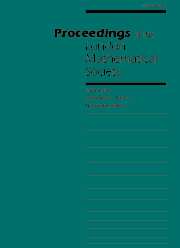Article contents
MULTIVARIATE R-O VARYING MEASURES PART I: UNIFORM BOUNDS
Published online by Cambridge University Press: 01 July 2000
Abstract
A finite Borel measure $\mu$ on $\mathbb R^d$ is called R-O varying with index $F$ if there exist a$\operatorname{GL}(\mathbb R^d)$-valued function $f$ varying regularly with index $(-F)$, an increasing function $k : (0,\infty)\to (0,\infty)$ with $k(t)\to\infty$ and $k(t+1)/k(t)\to c\geq 1$ as $t\to\infty$, and a $\sigma$-finite measure $\phi$ on$\mathbb R^d\setminus\{0\}$ such that\[k(t)\cdot(f(k(t))\mu)\to\phi\quad\text{as $t\to\infty$.}\]R-O varying measures generalize regularly varying measures introduced by Meerschaert (see M.~M.~Meerschaert, `Regular variation in $\mathbb R^k$', {\it Proc.\ Amer.\ Math.\ Soc.} 102 (1988) 341--348) and have numerous applications in limit theorems for probability measures.For an R-O varying measure $\mu$ and $-\infty<\infty$ let\begin{equation*}\begin{split}V_a(t,\theta) &= \int_{|\langle x,\theta\rangle|>t}|\langle x,\theta\rangle|^a\,d\mu(x),\\U_b(t,\theta) &= \int_{|\langle x,\theta\rangle|\leq t}|\langle x,\theta\rangle|^b\,d\mu(x)\end{split}\end{equation*}denote the tail- and truncated moment functions of $\mu$ in the direction $\|\theta\|=1$. The purpose of this paper is to show that R-O variation of a measure implies sharp bounds on the growth rate of the tail- and truncated moment functions depending on the real parts of the eigenvalues of the index $F$ along a compact set of directions. Furthermore, bounds on the ratio of thesefunctions for certain values of $a$ and $b$ are obtained. 1991 Mathematics Subject Classification: 60B10, 28C15.
Information
- Type
- Research Article
- Information
- Copyright
- 2000 London Mathematical Society
- 3
- Cited by

